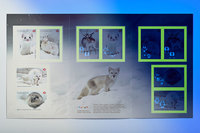
| Name | Value |
|---|---|
| Date of Issue | February 16, 2021 |
| Year | 2021 |
| Quantity | 670,000 |
| Denomination |
 PERMANENT™ (P). PERMANENT™ (P).Current monetary value: $0.92. |
| Series | Snow Mammals |
| Series Time Span | 2021 |
| Postal Administration | Canada |
| Condition | Name | Avg Value |
|---|---|---|
| No Prices for stamp | ||











Life in the wild can be a deadly game of hide and seek, where blending in with the landscape is critical to survival. These stamps – issued in the depths of our Canadian winter – showcase five native mammals that share the remarkable characteristic of changing colour with the seasons.
Not surprisingly, given the drastic change much of our landscape undergoes from summer to winter, Canada is home to more species of mammals that moult from shades of brown or grey to white – and back again in spring – than any other country in the world.
The five featured on these stamps represent the hunters and the hunted. The ermine and the Arctic fox are predators that blend into the snowy background to sneak up on their next meal. The snowshoe hare, Peary caribou and northern collared lemming are prey that rely on their camouflage to avoid detection.
“These creatures are like ghosts, travelling on or under the snow without a sound,” says Dominique Fauteux, a research scientist at the Canadian Museum of Nature. “Their unique adaptation invokes a very poetic view of winter as not only silent and calm, but also dangerous.”
The seasonal change of outerwear that makes these mammals distinctive is the result of a complex physiological process influenced by sensitivity to changes in daylight, rather than temperature. Starting around the first snowfall, their lighter-weight, darker-coloured coats moult to a heavier, more insulating white. This gradual process reverses in the warmer months, beginning around the spring melt.
Only 19 species of mammals worldwide (about 0.3 per cent) change colour in response to winter: Canada is home to 12 of them.
Canada Post originally planned on printing 300,000 booklets of the Snow Mammals issue. However, due to the media attention that these stamps generated and the high demand for these stamps, Canada Post decided to print 400,000 booklets instead to unsure that everyone got their paws on them.